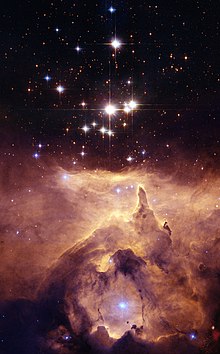

| Emission nebula | |
|---|---|
| H II region | |

NGC 6357 composite image
| |
| Observation data: J2000 epoch | |
| Right ascension | 17h24m [1] |
| Declination | −34° 20′[1] |
| Distance | ~5900±450[2] ly (1800±140 pc) |
| Constellation | Scorpius[3] |
| Designations | War and Peace Nebula,[1] Lobster Nebula [4] Sharpless 11, RCW 131, Gum 66, Madokami |
| See also: Lists of nebulae | |
NGC 6357 is a diffuse nebula near NGC 6334 in the constellation Scorpius. The nebula contains many proto-stars shielded by dark discs of gas, and young stars wrapped in expanding "cocoons" or expanding gases surrounding these small stars. It is also known as the Lobster Nebula.[4][5] This nebula was given the name War and Peace Nebula by the Midcourse Space Experiment scientists because of its appearance, which, in infrared images the bright, western part resembles a dove, while the eastern part looks like a skull.[6] A petition by anime fans to rename it as the Madokami nebula, due to resemblance with a character, was unsuccessful.[7][8]
It is located about ~5,500 light years away from Earth.[9]


This nebula includes the open cluster Pismis 24, which is home to several massive stars. One of the brightest stars in the cluster, Pismis 24-1, was thought possibly to be the most massive on record, approaching 300 solar masses, until it was discovered to be a multiple system of at least three stars; component stars would still remain near 100 solar masses each, making them among the more massive stars on record.[10][11]
The young stellar cluster G353.2+0.7 lies east of Pismis 24 and was revealed by a Chandra X-ray image showing approximately 800 stars.[12]
The young stellar cluster G353.1+0.6 lies southeast of Pismis 24 and also contains approximately 800 stars detected by X-ray.[12] The region includes several O-type stars, including [BDSB2003] 10.[13]
NGC 6357 is one of the most prominent sites of massive-star formation in our neighborhood of the Milky Way. A variety of early O-type stars reside in this nebula, blowing the bubbles around the star clusters that can be seen in the molecular cloud.
| Star name | Spectral type | Magnitude (Mbol) |
Temperature[15] (K) |
Radius (R☉) |
Mass (M☉) |
|---|---|---|---|---|---|
| WR 93 (HD 157504) | WC7 | -11.2 | 71,000 | 10 | 120 |
| Pismis 24-1NE | O3.5 If* | −10.0 | 42,000 | 17 | 74 |
| Pismis 24-1SW | O4 III | −9.8 | 41,500 | 16 | 66 |
| Pismis 24-2 | O5.5 V(f) | −8.9 | 40,000 | 12 | 43 |
| Pismis 24-3 | O8 V | −7.7 | 33,400 | 9 | 25 |
| Pismis 24-10 | O9 V | −7.2 | 31,500 | 8 | 20 |
| Pismis 24-12 | B1 V | −5.3 | 30,000 | 4 | 11 |
| Pismis 24-13 | O6.5 III((f)) | −8.6 | 35,600 | 12 | 35 |
| Pismis 24-15 | O8 V | −7.8 | 33,400 | 10 | 25 |
| Pismis 24-16 | O7.5 V | −9.0 | 34,000 | 16 | 38 |
| Pismis 24-17 | O3.5 III | −10.1 | 42,700 | 17 | 78 |
| Pismis 24-18 | B0.5 V | −6.4 | 30,000 | 6 | 15 |
| Pismis 24-19 | B0.5 V | −5.4 | 30,000 | 4 | 11 |